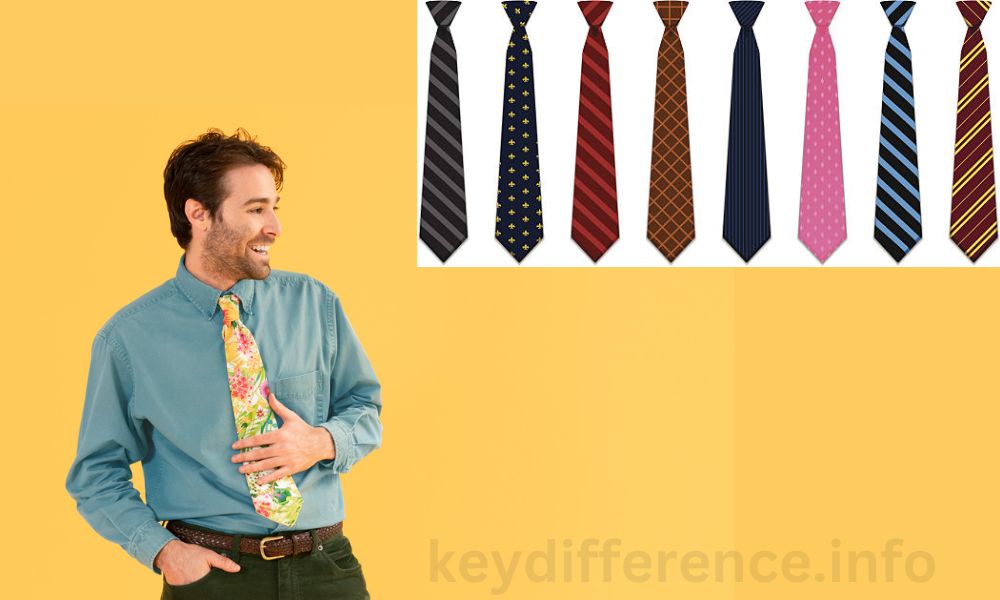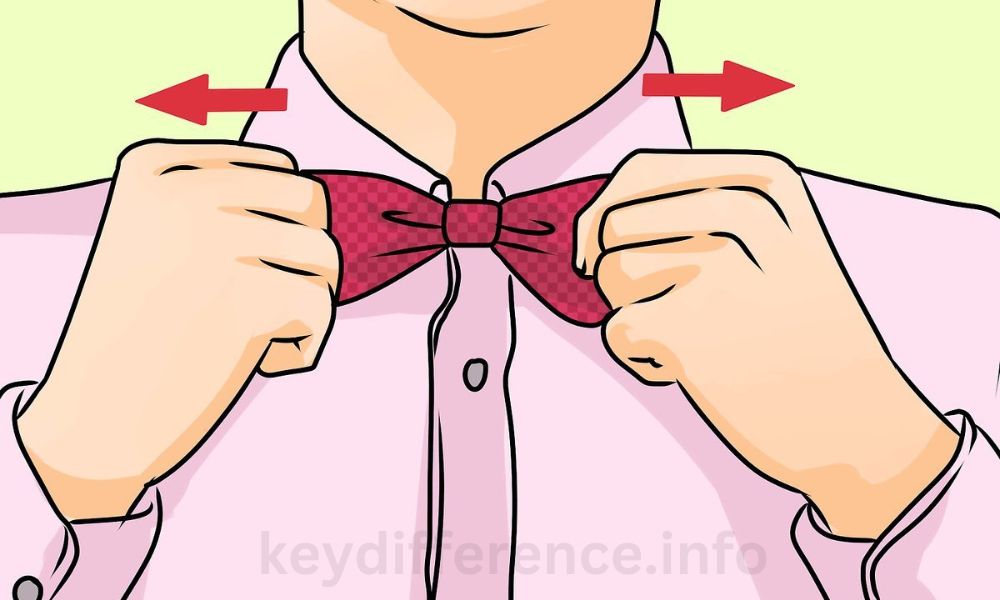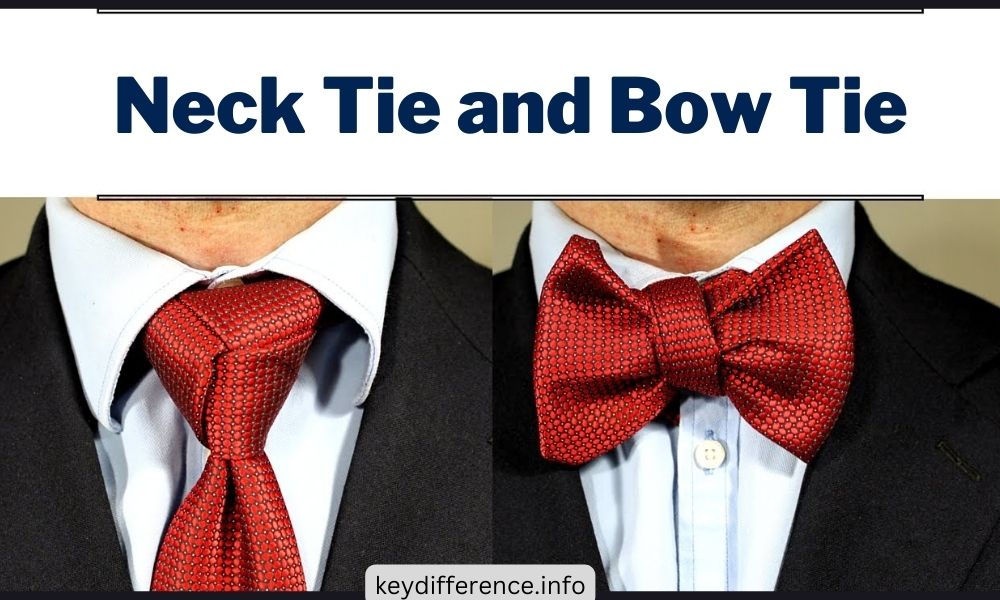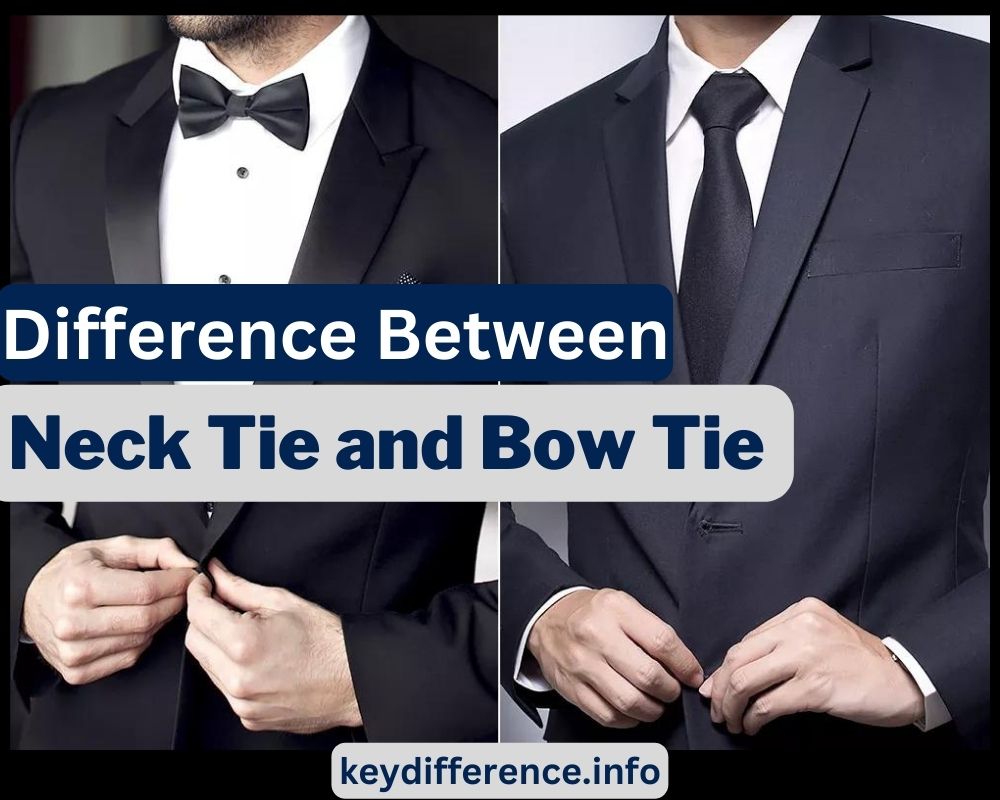A Neck Tie and Bow Tie are two types of tie based upon the size of both. Both are made from material and are tied on the neck. They are available in a variety of styles and patterns. It is typically worn to formal events or work.
What is Neck Tie?
A necktie is a long, narrow strip of fabric that is worn around the neck, typically beneath the collar of a shirt. It is a common accessory in men’s formal and business attire. Neckties are primarily worn to enhance the aesthetic appeal of an outfit and add a touch of sophistication.
They come in various styles, patterns, and colors, allowing individuals to express their personal style and complement their attire. Neckties are typically made of silk, polyester, or other materials and are tied using various knotting techniques. They are commonly worn in professional settings, formal events, and special occasions.

Description and characteristics
Description and characteristics of a Neck Tie:
- Shape and Size: Neck ties are long and narrow, typically measuring around 55 to 60 inches in length and 3 to 4 inches in width. The shape is usually rectangular or slightly tapered.
- Fabric: Neck ties are commonly made of silk, polyester, or a blend of these materials. Silk ties are known for their luxurious and smooth texture, while polyester ties are more affordable and durable.
- Patterns and Colors: Neck ties come in a wide range of patterns and colors, offering versatility in style. Common patterns include stripes, plaids, polka dots, paisleys, and solids. The color choices are extensive, ranging from subtle neutrals to vibrant hues.
- Knot Styles: Neck ties can be tied using different knot styles, such as the Windsor knot, Half-Windsor knot, Four-in-Hand knot, and Pratt knot. Each knot style creates a distinct look and affects the size and symmetry of the tie knot.
- Versatility: Neck ties are versatile accessories that can be worn with various shirt collars, including spread collars, point collars, and button-down collars. They can be paired with suits, dress shirts, and even some casual attire, adding a touch of elegance to the overall look.
- Formality: Neck ties are often associated with formal and business attire, lending a professional and polished appearance. They are commonly worn in corporate settings, interviews, weddings, and other formal events.
- Adjustability: Neck ties are adjustable in length, allowing the wearer to customize the fit and achieve the desired look. The length of the tie is typically adjusted by sliding the narrow end through a loop called the keeper or holder on the backside of the wide end.
- Style Expression: Neck ties offer individuals an opportunity to express their personal style and fashion preferences. The choice of patterns, colors, and knot styles can convey different aesthetics, ranging from classic and traditional to bold and contemporary.
History and evolution
History and evolution of Neck Ties:
- Ancient Origins: The concept of neck adornment can be traced back to ancient civilizations. Chinese warriors in the Qin Dynasty (221-206 BC) were known to wear cloth neckpieces, while Roman soldiers wore neck cloths known as focalia.
- Croatian Influence: The precursor to the modern neck tie can be attributed to Croatian mercenaries in the 17th century. These mercenaries wore knotted scarves around their necks, which caught the attention of French soldiers. The French term “cravate” was derived from the Croatian word “Hrvatska,” meaning Croatian.
- The Birth of Neck Ties: In the 18th century, the cravat gained popularity in Europe as a fashionable accessory. It was worn by the aristocracy and became a symbol of elegance and refinement. Cravats were often intricately folded and tied in various styles, with lace and frills added for embellishment.
- The Ascot Tie: In the late 19th century, the cravat evolved into the Ascot tie, named after the renowned Ascot Racecourse in England. This tie featured a wide, loose knot and was typically worn with morning coats or formal daywear.
- The Modern Neck Tie: The modern neck tie, as we know it today, emerged in the early 20th century. The invention of the four-in-hand knot, a simple and practical knotting technique, revolutionized tie-wearing. Neck ties became more streamlined, elongated, and easier to tie.
- Influence of Fashion Movements: Throughout the 20th century, neck ties experienced various fashion trends and shifts. In the 1920s, narrow and colorful ties gained popularity during the Art Deco era. In the 1940s, wide and bold ties with flamboyant patterns were in vogue. The 1960s saw the rise of skinny ties as part of the Mod subculture.
- Contemporary Styles: In modern times, neck ties come in a vast array of styles, patterns, and materials. They continue to be an essential accessory in men’s formal and business attire, while also offering versatility in casual and creative fashion contexts.
The evolution of neck ties showcases their transformation from simple cloth neckpieces to fashion statements that have transcended centuries and cultural boundaries.
Styles and variations
Styles and variations of Neck Ties:
Standard Neck Tie
- This is the most common style of neck tie, characterized by its long and narrow shape. It is typically worn in professional and formal settings, ranging from business meetings to weddings. Standard neck ties offer a wide range of patterns, colors, and fabrics to suit different preferences and occasions.
Skinny Tie
- Also known as slim ties, skinny ties are narrower in width compared to standard neck ties. They gained popularity in the 1960s and have made a comeback in recent fashion trends. Skinny ties offer a more contemporary and youthful look, often paired with fitted suits and slim-cut shirts.
Bow Tie Neck Tie
- A bow tie neck tie combines elements of both a standard neck tie and a bow tie. It features a pre-tied bow tie attached to a fabric strip that resembles a neck tie. This style provides the appearance of a bow tie with the convenience of a neck tie, suitable for those who prefer the bow tie aesthetic without the need for tying it themselves.
Knit Tie
- Knit ties are made from knitted fabrics, offering a unique texture and appearance. They have a more casual and relaxed vibe compared to traditional silk or polyester ties. Knit ties are versatile and can be paired with both formal and casual outfits, adding a touch of texture and visual interest.
Bolo Tie
- The bolo tie, also known as a string tie or cowboy tie, is a distinctive type of neck tie associated with Western and Southwestern fashion. It consists of a decorative clasp or slide that holds a braided leather cord together, with metal or stone embellishments. Bolo ties are commonly worn in less formal settings and are considered a statement piece.
Ascot Tie
- The Ascot tie is a wide, formal neck tie with a pointed end that is traditionally worn with morning coats or formal daywear. It is often made of silk or patterned fabric and tied in a loose, nonchalant knot. Ascot ties evoke a vintage and sophisticated look, suited for elegant occasions.
Cravat
- The cravat is an ancestor of the modern neck tie and is typically worn as a formal accessory. It is a wide, draped neckcloth that can be folded and tied in various elaborate styles. Cravats offer a classic and refined look, often associated with historical or period costumes.
These are just a few examples of the many styles and variations of neck ties available today. Each style offers its own unique aesthetic and can be chosen based on personal preference, outfit, and the desired level of formality.
What’s Bow Tie?
A bow tie is a type of neckwear that consists of a fabric bow, typically made of silk or polyester, which is tied around the collar of a shirt. Unlike a neck tie, which is a long strip of fabric, a bow tie is a distinct shape in the form of a bow with two loops and two ends.
Bow ties are known for their classic and formal appeal, often worn in black tie events, weddings, and other formal occasions.

Description and characteristics
Description and characteristics of a Bow Tie:
- Shape: A bow tie is characterized by its distinctive bow shape, consisting of two loops and two ends. The loops create a rounded, bow-like appearance, while the ends hang down on either side.
- Fabric: Bow ties are typically made of silk, polyester, or other materials. Silk bow ties are highly regarded for their luxurious and smooth texture, while polyester bow ties offer affordability and durability.
- Adjustability: Bow ties are designed to be adjustable to fit different neck sizes. They typically feature a sliding mechanism or a hook-and-eye closure at the back, allowing the wearer to customize the fit for comfort and style.
- Styles and Sizes: Bow ties come in various styles, with the most common being the butterfly, batwing, and diamond-point styles. Butterfly bow ties have wider wings, while batwing bow ties have narrower, straight-edged wings. Diamond-point bow ties have pointed ends that create a diamond shape. Bow ties also come in different sizes, ranging from small and compact to larger and more statement-making.
- Formality: Bow ties are often associated with formal occasions and black-tie events. They are a popular choice for weddings, gala dinners, and high-end parties. Bow ties add an elegant and sophisticated touch to formal attire and are considered a classic choice for men’s formal wear.
- Versatility: While traditionally worn in formal settings, bow ties have become more versatile and can be incorporated into casual and creative fashion styles. They can be paired with dress shirts, blazers, vests, and even with more casual attire to add a touch of individuality and flair.
- Fashion Statements: Bow ties have a timeless appeal and can make a bold fashion statement. They allow wearers to showcase their personal style and express their creativity. Bow ties come in a wide range of colors, patterns, and textures, allowing individuals to experiment and stand out in their sartorial choices.
- Popularity: Bow ties are favored not only by men but also by women as a fashion accessory. They have gained popularity in recent years as a gender-neutral and fashion-forward item, worn by individuals who appreciate the classic yet contemporary aesthetic of bow ties.
Bow ties are known for their elegance, charm, and ability to elevate an outfit. Whether worn for formal or casual occasions, they are versatile accessory that adds a touch of sophistication and individuality to one’s attire.
History and evolution
History and evolution of Bow Ties:
- Origins: The bow tie traces its origins back to the 17th century, when Croatian mercenaries wore knotted scarves around their necks. These scarves, known as “cravats,” caught the attention of French aristocracy, leading to the term “cravate” and the adoption of the bow tie as a fashion accessory.
- 18th Century: The bow tie gained popularity in the 18th century, particularly during the reign of Louis XIV in France. It was worn by the upper class as a symbol of elegance and refinement. The style of the bow tie evolved during this period, with bows becoming larger and more extravagant.
- 19th Century: In the 19th century, the bow tie took different forms. The “black tie” bow tie, also known as the “dinner tie,” emerged as a formal accessory for evening events. The bow tie was often made of black silk and paired with a tuxedo or dinner jacket.
- 20th Century: The bow tie continued to evolve throughout the 20th century. In the early 1900s, bow ties were predominantly worn in formal settings, such as weddings and upscale events. They were often associated with academia, worn by professors and intellectuals.
- Bow Ties and Fashion Movements: In the mid-20th century, bow ties experienced a shift in popularity. During the 1950s and 1960s, bow ties were embraced by the “Ivy League” style, associated with collegiate fashion and preppy culture. They were often worn with button-down shirts, blazers, and khaki pants.
- Modern Variations: In recent decades, the bow tie has made a resurgence in fashion. It has become a statement piece and a way for individuals to express their personal style. Bow ties are now available in a wide array of colors, patterns, and materials, allowing for more experimentation and individuality.
- Bow Ties Beyond Formality: While traditionally associated with formal attire, bow ties have transcended their formal origins. They are now worn in a variety of settings, from weddings and black-tie events to creative fashion contexts and even casual streetwear. Bow ties have become a symbol of confidence, style, and self-expression.
The bow tie’s journey from its Croatian origins to its place in contemporary fashion demonstrates its enduring appeal and ability to adapt to changing trends. Whether worn as a classic accessory or as a fashion-forward statement, the bow tie continues to be a distinctive and stylish choice for both men and women.
Styles and variations
Styles and variations of Bow Ties:
Butterfly Bow Tie
- The butterfly bow tie is the most common and classic style. It features a symmetrical, wide, and rounded shape, resembling the wings of a butterfly. This style is often associated with formal attire and is a popular choice for black-tie events and weddings.
Batwing Bow Tie
- The batwing bow tie is characterized by its narrow and straight-edged wings. It has a sleek and minimalist appearance, offering a more modern and understated look. The batwing style is suitable for both formal and semi-formal occasions, providing a contemporary twist to traditional bow ties.
Diamond-Point Bow Tie
- The diamond-point bow tie has pointed ends that extend diagonally outward from the center of the bow, creating a diamond-like shape. This style adds a unique and distinctive touch to the bow tie, allowing for a more dynamic and eye-catching appearance. Diamond-point bow ties are often chosen by individuals looking to make a bold fashion statement.
Oversized Bow Tie
- Oversized bow ties feature larger bows, creating a more dramatic and statement-making look. These bow ties can be an attention-grabbing accessory and are favored by those seeking a unique and fashion-forward appearance. Oversized bow ties work well for special occasions, parties, and creative fashion ensembles.
Self-Tie Bow Tie
- Also known as a “tie-it-yourself” bow tie, the self-tie style requires the wearer to manually tie the bow themselves. This style offers a sense of authenticity and allows for customization of the bow’s size and shape. Self-tie bow ties provide a classic and traditional look and are preferred by those who enjoy the process of tying a bow.
Pre-tied Bow Tie
- Pre-tied bow ties come with a pre-formed bow that is permanently fixed and ready to wear. They are convenient and easy to put on, making them a popular choice for those who prefer a hassle-free option. Pre-tied bow ties are available in a wide range of styles and sizes, catering to various preferences and occasions.
Bow Tie with Patterns and Prints
- Bow ties come in a multitude of patterns and prints, allowing for endless style possibilities. They can feature stripes, plaids, polka dots, paisleys, florals, novelty prints, and more. Patterned bow ties add visual interest and personality to an outfit, making them a versatile choice for both formal and casual occasions.
Bow Tie Materials
- Bow ties are crafted from various materials, including silk, polyester, cotton, wool, velvet, and even unconventional materials like leather or wood. Each material provides a unique texture, appearance, and level of formality, allowing individuals to select a bow tie that suits their desired look and occasion.
These styles and variations offer a range of choices for individuals to find the perfect bow tie that matches their personal style, event, and outfit. From classic and refined options to bold and creative designs, bow ties provide a versatile and fashionable accessory for both formal and casual wear.
Comparison table of Neck Tie and Bow Tie
Here’s a comparison table highlighting the key differences between Neck Ties and Bow Ties:
| Aspect | Neck Tie | Bow Tie |
|---|---|---|
| Style | Long strip of fabric worn around the neck | Symmetrical, bow-shaped accessory around the neck |
| Formality | Typically more formal | Versatile, suitable for both formal and casual |
| Knot Complexity | Easier to tie with various knots | Requires a specific bow-tying technique |
| Occasions | Business meetings, formal events | Weddings, parties, casual gatherings |
| Knot Options | Windsor, Half-Windsor, Four-in-Hand, Pratt, etc. | Butterfly, Batwing, Diamond, Straight-End, etc. |
| Variety | Available in various widths, patterns, and fabrics | Offers creative patterns, colors, and materials |
| Expression of Style | Conveys professionalism and tradition | Expresses individuality and a touch of whimsy |
| Suit Compatibility | Matches well with suits and blazers | Can be paired with suits, tuxedos, and blazers |
| Shirt Compatibility | Matches with dress shirts and collared shirts | Goes well with dress shirts and formal attire |
| Gender Inclusivity | Primarily worn by men | Embraced by all genders and non-binary individuals |
| Maintenance | Requires careful tying and adjusting | Simple to put on and adjust |
| Popularity | Widely worn in formal settings | Gaining popularity in modern fashion |
Similarities between Neck Tie and Bow Tie
Similarities between Neck Tie and Bow Tie:
- Both neck ties and bow ties are accessories worn around the neck as a decorative element to complement formal or semi-formal attire.
- Both neck ties and bow ties are commonly associated with formal occasions and dress codes. They are often worn with suits, tuxedos, or other formalwear.
- Both neck ties and bow ties come in a wide range of styles, colors, patterns, and materials, allowing individuals to choose options that suit their personal preferences and match their outfit.
- Both neck ties and bow ties can be used as fashion statements to express personal style and add a touch of individuality to an outfit.
- Both neck ties and bow ties are worn with collared shirts. They are designed to be worn with specific collar styles, such as the spread collar or wingtip collar.
- Both neck ties and bow ties have evolved in terms of style and design over time, adapting to changing fashion trends and preferences.
- While traditionally associated with men’s fashion, both neck ties and bow ties have gained popularity as unisex accessories, with many women incorporating them into their outfits for a stylish and fashion-forward look.
- Both neck ties and bow ties are commonly worn to formal events such as weddings, business meetings, gala dinners, and other special occasions.
Despite their differences, neck ties and bow ties share similarities in their purpose, role in formal attire, variety of styles, fashion statements, compatibility with collared shirts, fashion evolution, unisex appeal, and their association with formal occasions.
Choosing the Right Tie

Choosing the right tie involves considering several factors to ensure it complements your outfit and personal style. Here are some key considerations:
Occasion
- Consider the occasion or event you’re attending. Formal events like weddings or business meetings call for more traditional and conservative ties, while casual events may allow for more creativity and unique patterns.
Suit/Shirt Color
- Take into account the color of your suit or shirt. The tie should harmonize with the overall color scheme. For a classic look, choose ties that complement or contrast with the colors of your outfit.
Pattern and Color
- Decide on the pattern and color of the tie based on your personal style and the outfit’s overall aesthetic. Solid color ties are versatile and can be paired with a variety of patterns and colors. For a more playful or bold look, consider patterned ties like stripes, polka dots, plaids, or paisleys. Just ensure that the patterns do not clash with other patterns in your outfit.
Width and Length
- Consider the width and length of the tie. The width should be proportionate to the width of your lapels, and the length should be suitable for your torso height. Standard tie widths range from 3 to 3.75 inches, but wider or narrower options are available for different style preferences.
Fabric
- Choose a tie made of quality fabric. Common options include silk, polyester, wool, or a silk blend. Silk ties offer a luxurious look and feel, while polyester or wool ties may be more durable and affordable.
Personal Style
- Consider your personal style and the image you want to project. If you prefer a classic and timeless look, opt for conservative colors and patterns. For a more contemporary or fashion-forward style, you can experiment with bolder colors, patterns, or textured fabrics.
Knot Style
- The knot you choose to tie can impact the overall look of the tie. Common knot options include the four-in-hand knot, Windsor knot, or half-Windsor knot. Choose a knot that suits the width and thickness of the tie, and ensure it complements your collar style.
Confidence
- Choose a tie that makes you feel confident and comfortable. Your choice should reflect your personal taste and make you feel good when wearing it.
Remember to consider these factors while also expressing your individuality and personal style. Experiment with different combinations to find the perfect tie that completes your outfit and enhances your overall appearance.
Summary
Neck Tie and Bow Tie are both fashion accessories for males that are worn on the neck in conjunction when paired with a formal shirt. A necktie can be described as a long thin piece of fabric that is tied into knots, and can be found in different types, colors, and designs. The majority of people wear it for formal or business occasions.
The bow tie is smaller, pre-tied, or self-tied accessory that has two loops that form an arch. Bow tie is considered to be to be more elegant than neckties, and typically are worn to black tie occasions or for adding an elegant look to your attire.

